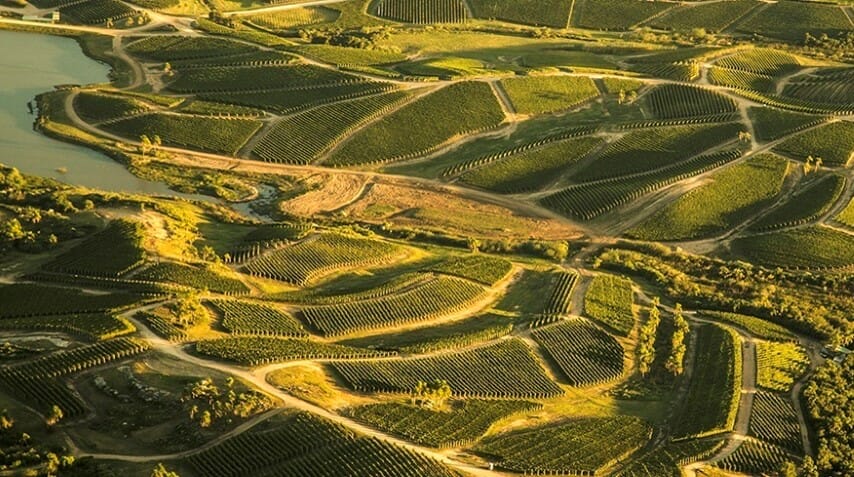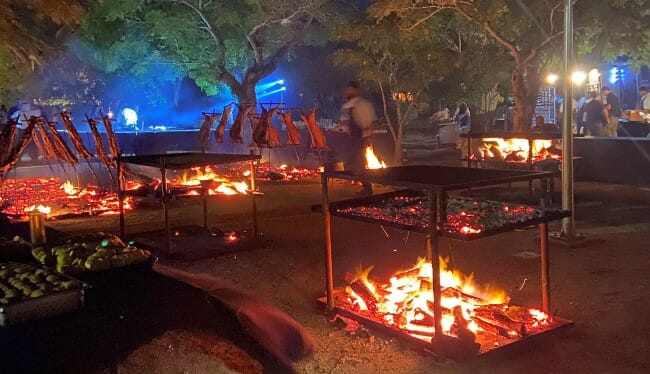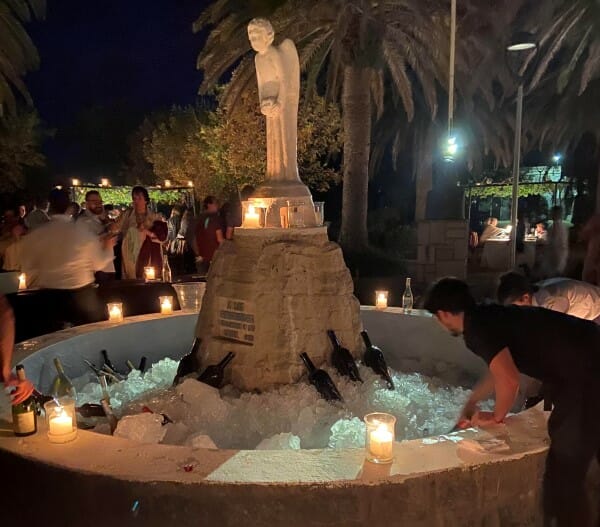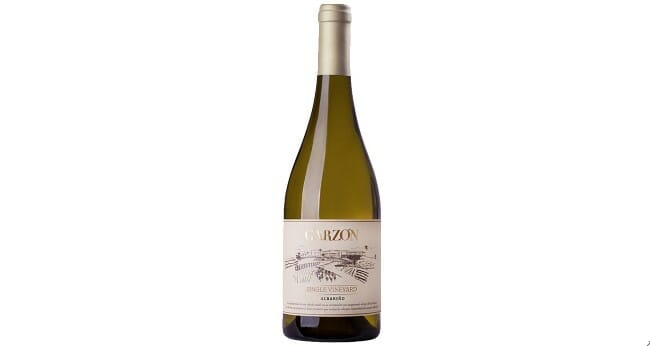Celebrating Harvest at Bodega Garzon, Immersed in Uruguayan Wine
Photos via Amy Glynn, Bodega Garzon
The autumn sun in Punta del Este, Uruguay, is vicious, even with the mercury at an eminently reasonable 78 Fahrenheit: That ozone hole is real. It takes 20 minutes for the UV to raise a blister on my exposed shoulder. I don’t notice; I’m watching a modern-day Bernini raising a tiny blizzard of white dust from the flank of a 10-foot block of snowy Carrara marble. Pablo Atchugarry is slowly turning this mass of stone into an abstracted pillar of wavelike curves, accordion folds and lines that suggest the trunk of a very ancient tree. It’s stunning, as it always is when you find yourself in the presence of one of those rare souls with a gift for illuminating the metaphors that underpin our experience. One of my companions asks whether he decides what he wants to sculpt and then makes it happen, or whether he goes in speculatively and lets the marble lay down the law. I know before Atchugarry opens his mouth that his answer will be “both.”
In Spanish, he notes that this is a twofold path of decision-making, that the art is informed equally by imagination and constraint, the physical reality of the material and the numinous landscape of the mind—by the structural properties of the stone, where the flaws and inclusions and impurities are as well as by his own hand-mind connection. Looking at this pillar of marble, in this high, limpid, searing sunlight, I’m struck by how insanely alive it seems. It glows, interpreting the sun’s rays through its matrix of metamorphosed carbonate and dolomite and silica. The sculptor raising the torrent of pale dust seems as illuminated by the stone as vice versa. Everything here is beautiful, burnished, glinting. Talk about a terroir. Clay, chalk, granite; the Atlantic, the Rio de la Plata, the relentless high-pitched light.
At home in California it’s budbreak, the opening beat in the complicated tango between a grapevine and a winemaker. In the southern hemisphere, it’s vindemia, the annual fall harvest. Up in Pueblo Garzon, only a few miles from here but seeming like another world, preparations are underway for Bodega Garzon’s harvest party, a lavish affair involving ceremonial cluster-clipping, a fire-obsessed celebrity chef, 300 alarmingly attractive guests, a painfully picturesque landscape, a whole lot of red meat and caramelized sugar, and an ocean of stellar wine.
 We’re talking LOTS of red meat.
We’re talking LOTS of red meat.
Uruguay is a small country with a population of 3 million, and it registers the influences of its neighbors, Argentina and Brazil, and those of cultures that shaped it in past centuries—Italy, France, Britain, Spain, Portugal. Winemaking here is old news, an industry that dates to the late 1800s, brought by Italian and Basque immigrants. We don’t see a ton of Uruguayan wine in the States, possibly because domestic consumption accounts for most of what is produced (these people have a taste for good stuff and I don’t wonder that they keep their wine a somewhat guarded secret). Happily, Bodega Garzon is an exception. You can find nearly everything I tasted on this trip at wine.com-and I would posit that you should make that a priority.
Bodega Garzon won Wine Enthusiast’s 2018 New World Winery of the Year accolade, and it isn’t difficult to understand why. The facility, owned by Alejandro Bulgheroni, an Argentine native with an energy-sector background, who now has wineries on four continents, is not unlike the man himself-well-groomed and elegant, but not flamboyant. And it’s multivalent, housing not just the usual caves and crushpads, tasting rooms and patio spaces, but a swanky club (containing more than one of Atchugarry’s mind-bending sculptures) that offers members exclusive experiences, including civilian winemaking. There’s a beautiful golf course and a restaurant whose presiding deity is the Patagonian Hephaestus, Francis Mallmann. The winery is state of the art, with an eye on sustainability (LEED certification, gravity systems, photovoltaic and wind generation; fancy concrete tanks alongside serious French foudres). The interior spaces are richly appointed, full of live-edge hardwood tables and slate and poured concrete—the whole place smells like wood and leather and BBQ smoke and chaparral and must and … well, money. It smells like money. It’s a level of splendor that could easily be intimidating or chilly, but it isn’t. Maybe it’s all the BTUs emanating from the multiple open-flame cooking areas, but honestly, “cold” is the last way you’d describe this place.
 Statuary doubles as a wine fridge.
Statuary doubles as a wine fridge.
Tannat is to Uruguay what Malbec is to neighboring Argentina—an immigrant from western Europe that has risen to become the emblem of a South American terroir, growing richer, more distinguished and more beautiful in its adopted land than it ever was in its original one. I went to Bodega Garzon hoping no one would learn my dirty little secret—tannat is generally everything I dislike in a red wine. The Basque native has extremist tendencies, logging potentially eyewatering alcohol and tannin levels; I wasn’t looking forward to having to metabolize a massive amount of it in varietal form. So there were two surprises for me: Tannat is rounder and more nuanced down here, and, although it might be the national grape of Uruguay it is not the only story at Bodega Garzon.
Bodega Garzon’s Tannats are a nice surprise; leafy and leathery from some angles, black-fruit-y from others, and grounded. For my money, even better are the Cabernet Francs (fleshly and redolent of big purple flowers; violet, wisteria, lilac, vetch) and their Marselan, a relatively recently-created viniferous Labradoodle with a Cabernet daddy and a Grenache mom. Marselan is Cab-ish but more aromatically expansive, with Grenache white pepper and raspberry notes, and softer tannins—and a notable absence of bell-pepper-bomb pyrazines. Garzon’s is splendid, one of the highlights of the tasting flight, especially if you are like me and prone to palate fatigue where Cabernet is concerned. Lighter on its feet and much more svelte than a Cab, Bodega Garzon Marselan is nonetheless sturdy enough to accompany the open-flame-cooked red meat that inevitably appears in a country where cattle outnumber humans three to one.
-

-

-

-

-

-

-

-

-

-

-

-

-

-

-

-

-

-

-

-

-

-

-

-

-

-

-

-

-

-

-

-

-

-

-

-

-

-

-

-

 A singular Albariño.
A singular Albariño.






































